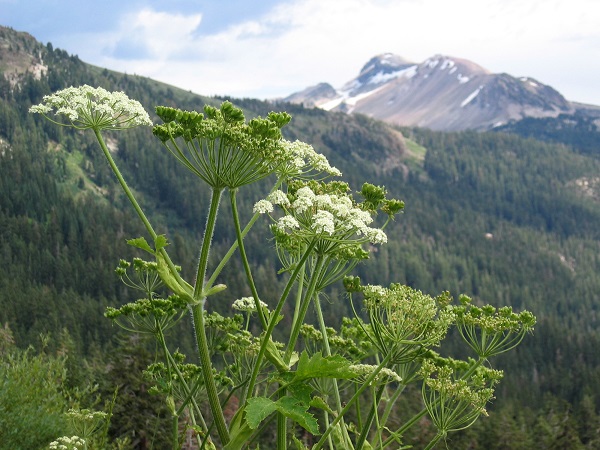| The Sandisfield Times |
|---|
| A New Invader in Sandisfield As if We Didn’t Have Enough to Worry About |
|
by Tom Christopher Published July 1, 2024. |
 (Photo: Wkipedia) |
|
“Giant Hogweed” sounds menacing, and it should. Reaching a height of 15 feet, this perennial weed from the Caucasus Mountains (known botanically as Heracleum mantegazzianum) has been described as “Queen Anne’s Lace on steroids” thanks to its lobed, deeply cut leaves that may measure 5 feet across and the flat-topped, umbrella-like white flowerheads that may be 2.5 feet in diameter. Giant hogweed poses significant threats to our local ecosystem (which I’ll get to in a moment), but the one that will probably most concern readers is its toxicity to human beings. If you happen to damage one of giant hogweeds leaves or stems and get its sap onto your skin, it will cause a rash that puts poison ivy to shame. Contact with hogweed sap combined with exposure to sunlight causes first a reddening of the skin followed within 48 hours by large and painful, fluid-filled blisters that may leave purplish or black scars on your skin. Mild cases of hogweed poisoning usually peak after three days and decline thereafter, but severe cases can last weeks or months and may require hospitalization. If you get even a minute quantity of the sap in your eyes, it can cause temporary or permanent blindness. | |

|
Why is This Thing Here? Plant collectors of the early 20th century admired this plant’s striking appearance and brought it home for cultivation in North America. Like most such introductions, giant hogweed eventually escaped into the wild and has formed colonies throughout the MidAtlantic states, including New York, and New England. And yet its use as a garden plant continues: in 2002, this toxic threat was found in three locations in Granville, Massachusetts, where it had escaped from a local’s garden. Three years ago, I found a specimen growing along Sandisfield’s Sears Road. Fortunately, this is the only occurrence I have found in Sandisfield to date. But we should all learn to identify this plant, if for nothing else so that we don’t expose ourselves to it accidentally. |
|
What Does it Look Like? Watch for giant hogweed in sunny spots with moist soils. Its most common habitat in North America is roadside ditches or the banks of stream. However, giant hogweed can also grow in partial shade and will sometimes spring up in damp fields and woodland openings. Because those huge flowerheads produce correspondingly large quantities of seeds – as many as 100,000 per plant – this menace can quickly form large, dense colonies, especially along waterways. When my wife Suzanne O’Connell and I found that single plant near our house, we took immediate action. I sprayed it with a strong solution of glyphosate, the active ingredient in the popular weed killer “Roundup.” This killed the plant’s growth back to the ground, but it sprang up again from its tuberous root the following spring. I repeated the treatment, with the same results. This spring, after slicing off the new growth with a spade, I dug up the root and pried it out of the soil. Hopefully this will finally finish the job. Recognizing this plant, even while still small, isn’t difficult. Cornell University maintains an illustrated online guide to its identifying characteristics. Briefly, look for the large, dissected leaves; coarse, round, green stems spotted with purple and dotted with raised nodules: and the stiff white bristles that cover the leaf stems and more sparsely the main stems themselves. The monstrous flowerheads, which are borne from late spring until mid-summer, are hard to miss.
 Cow parsnip, Heracleum maximum. (Photo: Wkipedia) You should also learn to identify its North American relative, cow parsnip (Heracleum maximum). This resembles the giant hogweed in its dissected leaves and parasol-like flowerhead, but the cow parsnip is smaller than the invader in all respects. It reaches a height of just 8 feet, with leaves to 2.5 feet in diameter and 1-foot flowerheads. One sure way to distinguish the two species is that the cow parsnip stems lack the purple spots and nodules found on the giant hogweed’s stem. It was by looking at the stems that I ascertained the large cluster of plants Suzanne noticed recently along the northern reaches of New Hartford Road was a colony of cow parsnips rather than giant hogweeds. That doesn’t mean it is harmless – cow parsnip also has a somewhat toxic sap which can raise a rash, but the effect is less virulent than that of the giant hogweed. Cow parsnip is also a less aggressive spreader because it is a native of our region and as such is grazed by a variety of wildlife including deer and moose. Black bears will dig and eat the fleshy roots. These attacks help keep cow parsnip in check. In contrast, as a recent arrival in our region, giant hogweed is not consumed by our wildlife, and its fast and rampant growth means it easily displaces native plants, depriving native insects and birds of accustomed food sources. By crowding out the other growth along stream banks, it can make them more prone to erosion. If you spot an invasion of giant hogweed, your first response should be to report it to the Massachusetts Department of Agricultural Resources at massnrc.org/pests/hogweedreport.aspx. The University of Massachusetts Amherst offers online recommendations for eradicating giant hogweed – you’ll find these by searching for “controlling giant hogweed in Massachusetts.” Cornell University offers more complete instructions at its New York Invasive Species Information website (nyis.info/) on the page dedicated to “Giant Hogweed.” Whatever approach you choose to pursue, be very cautious. Be sure to wear protective clothing, gloves, and safety goggles. This plant is not, plant collectors to the contrary, a striking garden ornament but rather a serious threat. | |

|
©The Sandisfield Times. All rights reserved.
Published July 1, 2024